Last updated on March 22, 2024
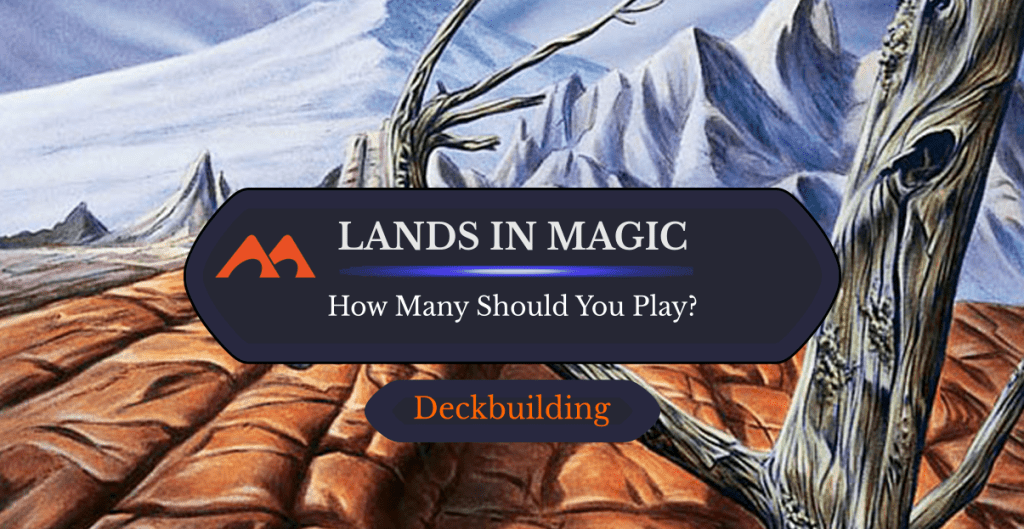
Wasteland | Illustration by Una Fricker
Magic: The Gathering revolves around casting cards and formulating strategies to outwit your opponents. But have you ever found yourself just 1 mana short of making a crucial play or experienced mana flooding? Well, there's a reason behind these situations: Your mana base might be off.
There's no secret formula to determine the precise amount of mana for every deck, but I want to bring you closer to that goal by analyzing the factors influencing your mana base and how they impact your overall objective of winning matches.
Did I catch your attention? Let's dive right in!
How Many Lands Should I Play?
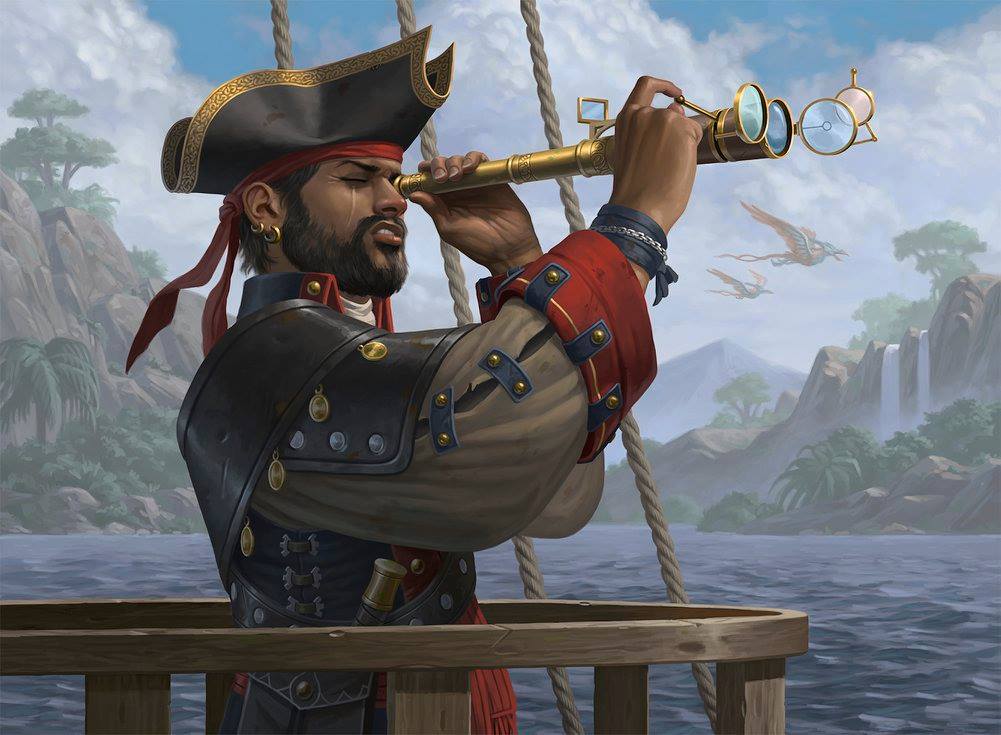
Opt | Illustration by Craig J. Spearing
Determining how many lands one has to play in MTG decks can vary between many factors like mana curve, mana requirement, and format. However, in most cases, having at least two lands in your initial hand is the sweet spot for most decks to operate at a decent pace. On that premise, we can make some calculations to determine the correct number.
The most popular MTG formats are broken down by 100, 60, and 40 cards each. Here are some numbers based on hypergeometric results you can utilize as a base.
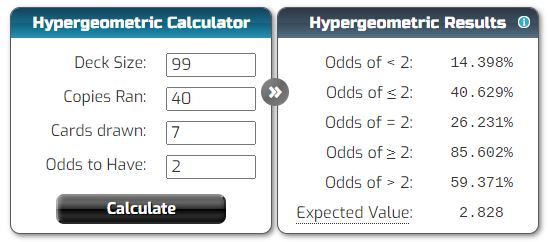
Hypergeometric land count for 100-card decks
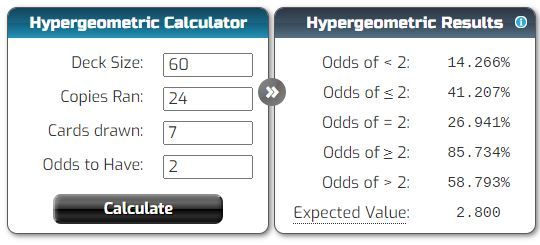
Hypergeometric land count for 60-card decks
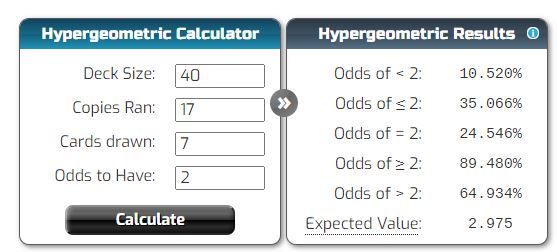
Hypergeometric land count for 40-card decks
I tried to tune each deck to draw at least two lands at least 85% of the time, and while it's far from a perfect number, it's a starting point you can use to start determining the number of lands your deck may need, depending on various other factors.
How Do I Calculate How Many Lands I Need?
The number of lands in a deck is determined by the format and the total number of cards in the deck. However, several factors can also influence this number, such as mana tutors, card ramp spells, cantrips, mana curve, and MDFCs (Modal Double-Faced Cards). Each carries a certain weight, which we’ll discuss to help you estimate the appropriate number of lands for your deck.
I’ll provide you with the basic method I used for these calculations, and if you have the time, you can utilize an online hypergeometric calculator to replicate these results.
The mana curve significantly affects the number of cards you can play in your decks. Ideally, you’d like to consistently hit your land drops to reach the necessary mana to cast your spells. For instance, if your average mana value is 4, you’d ideally want to have drawn at least four lands among your initial 11 cards to ensure you can play your cards on curve. Using the Hypergeometric Calculator, we find that in a 60-card deck, you’d need to include 26 lands to reliably hit four lands among your initial 11 cards, giving you an 80% chance of always having a fourth land by turn 4.
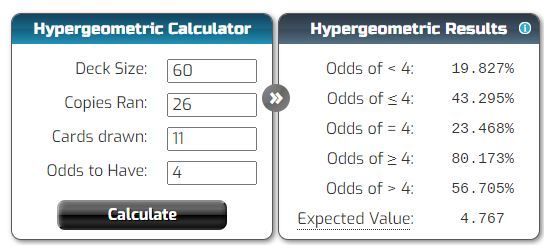
Hypergeometric odds of hitting land #4 by turn 4
On the other hand, if your curve is as low as 2 mana, as is the case across most Pauper and Legacy decks, you’d need to run at least 20 lands to get over the 80% threshold of getting two lands in your eight initial card draws.
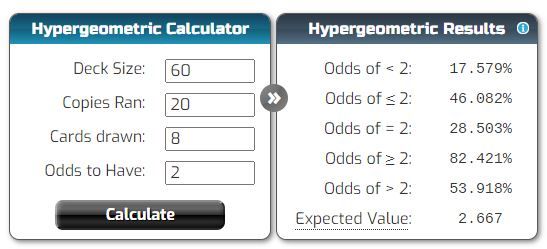
Hypergeometric odds of hitting land #2 by turn 2
Commander/Historic Brawl
The overall number of lands you want to run to have at least two in your initial hand is 40. However, this number can change depending on the overall curve of mana: The lower it is, the fewer lands you’d likely play and vice versa.
Mana ramp cards like Sol Ring or Coldsteel Heart also help to determine the number of lands you can play, since these ramp spells let you hit the determined spot of mana where your deck operates the best.
Draft and Sealed
For both formats, the standard number of lands is typically 17. However, aggressive decks may go as low as 15 lands if they’re mono-colored, and 16 lands for 2-color decks. It's quite uncommon for decks with more than two colors to have fewer than 17 lands, but cards like Many Partings or Brave the Wilds can reduce this number.
The key to this approach is sticking to a single color, prioritizing it over your mana distribution, and ensuring you have no fewer than eight sources of that color to fix your mana
Standard
In Constructed formats, it depends on the deck archetype as aggressive decks tend to run from 23 to 24 lands, midrange decks run from 24 to 25 lands and control decks run at least 26 lands. Usually, Standard is a format where there aren't many modifiers like cantrips or MDFCs, so these numbers won't vary as much across seasons.
Pioneer
Unlike Standard, Pioneer benefits from the availability of cost-effective mana dorks like Llanowar Elves and cantrips like Opt. However, what truly sets this format apart is that powerful cards like Fatal Push and certain creatures like Thing in the Ice or Luminarch Aspirant come at a lower cost, reducing the overall curve of the decks where they’re utilized.
For tempo decks like Izzet Phoenix, you typically aim for around 18 lands, while the most aggressive ones require 22 to 23 lands. The midrange decks usually feature an average of 24 lands.
Control decks are relatively scarce, and they typically run between 26 to 27 lands. Despite having access to cheap removal spells, they also rely on impactful cards like Teferi, Hero of Dominaria as win conditions. Therefore, they prioritize playing these cards on curve as frequently as possible by running a high number of lands.
Modern
In the Modern format, things tend to move swiftly. Cards like Ragavan, Nimble Pilferer pose a significant threat, Lightning Bolt stands out as an efficient removal spell, and Preordain is considered one of the best cantrips ever printed. What unites these cards is their 1-mana cost. Most Modern decks cap their curves at 3 mana. Even though cards like Fury or Force of Negation may seem mana-expensive at first glance, they're often cast for free, so they don't affect your land count. Typically, Modern decks run between 18 to 23 lands, depending on whether they're blue-based, aggressive, or midrange/control decks.
Pauper
Similar to Modern, Pauper decks feature low curves, and it's unusual to see cards exceeding a 3-mana cost. Decks in Pauper can range from as low as 18 lands up to 23, in rare cases, for the more expensive ones.
Legacy
Pauper is often referred to as the “Legacy Lite” version of the actual Legacy format for a good reason. It shares almost the same card pool with Legacy, but the latter enjoys a better mana base thanks to dual lands like Tropical Island that can be searched to fix your mana using fetch lands. Brainstorm plays a crucial role in these decks, allowing you to manipulate your library alongside the search effects from fetch lands. Consequently, most decks tend to run around 18 lands each. Decks that rely on fast mana, like combo decks, can go as low as 14 lands, as they make use of mana rocks like Lotus Petal or cards like Dark Ritual to add mana and cast as many spells as they can to execute their combo.
Vintage
While I lack extensive experience with Vintage, I've found that due to the format's access to powerful artifacts from the Power 9, it's uncommon to see decks exceed the 18-land threshold. Vintage decks typically run an average of 14 to 16 lands, depending on their chosen strategy.
How Many Lands Do You Need for Splashing?
The number of lands you should include when splashing cards from other colors depends on the number of cards you intend to add that differ from your deck's primary colors.
In Limited formats, ideally, you'd want to have three or more lands for each card of the color you're splashing. However, this may vary based on cards that can fulfill a similar role as a color fixer, like Utopia Sprawl or Treasure token generators.
The concept is quite similar in Constructed formats, but following the advice of MTG player and mathematician Frank Karsten, the optimal range for adding another color to your deck in a 60-card format is approximately 12 to 13 sources of mana per color.
When Should You Play Lower Land Counts?
Another significant factor affecting your deck's land requirements is the inclusion of card draw spells, particularly cheap ones often referred to as “cantrips.” This category encompasses cards like Brainstorm, Faithless Looting, Deadly Dispute, and most other cards that let you draw additional cards for less than 2 mana. It even includes cards like Hard Evidence, where you can spend 2 mana to create a Clue token and crack it to draw another card.
These cantrips assist you in delving deeper into your library, allowing you to draw more cards to access the spells you need or hit those crucial land drops.
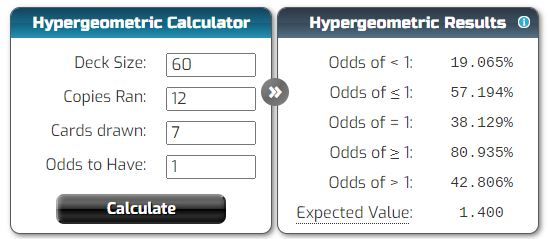
Hypergeometric odds of drawing one out of 12 cantrips on turn 1.
With approximately 12 of these effects in your deck, you can consistently have at least one by turn 1 and use it to search for a second land if necessary. In my experience, with this many cantrips, you can get away with running as few as 18 lands without encountering mana-related issues.
Following the same principle, you can adjust your land count based on the number of cost-effective mana-producing creatures in your deck like Llanowar Elves, or cards that help you retrieve lands like Many Partings, which essentially functions as having an extra land in hand. However, when relying on mana dorks, be mindful of whether they’re vulnerable to removal in specific metagames. If your environment is full of inexpensive removal spells, these creatures may frequently be targeted, so consider this when deciding.
On the other hand, Modal Double-Faced Cards (MDFCs) like Jwari Disruption occupy a unique space, but I typically consider them equivalent to one-third of a land. Therefore, you could theoretically reduce your deck's land count by one if you run three of these cards.
You can't overlook the “hand-smoother” mechanic in Arena's best-of-one games. The exact mechanics are unknown to me, but essentially, it guarantees that you’ll have at least a couple of lands in your starting hand around 90% of the time. It's not uncommon to reduce land counts in decks designed for aggressive strategies to take advantage of this feature.
Wrap Up
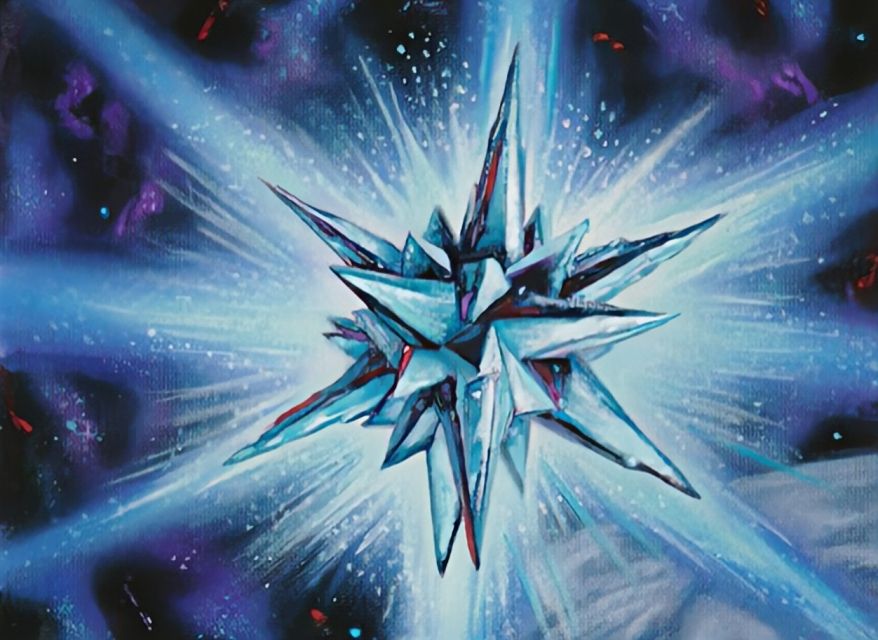
Coldsteel Heart | Illustration by Mark Romanoski
Determining the appropriate number of lands to include in MTG decks is a crucial decision that significantly influences gameplay. It certainly isn’t one set in stone as there are multiple factors that lead you to the right amount of mana your deck needs. If you were to ask me, the curve is the one predominant thing that should tell you how many lands you should play, followed by the format and overall strategy.
I hope you’ve found this article useful, and if you'd like to keep reading other exciting ones, I encourage you to follow us on Twitter/X and Discord to never miss a thing!
As always, it’s been a delight researching and delivering my findings to you. Take care, and see you next time!
Follow Draftsim for awesome articles and set updates:

Add Comment